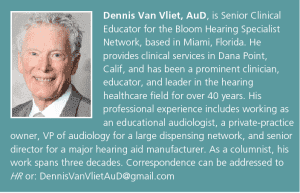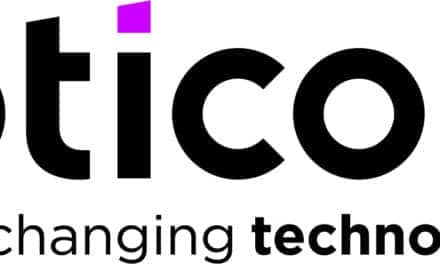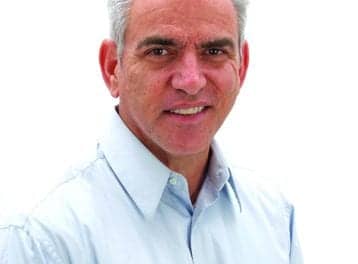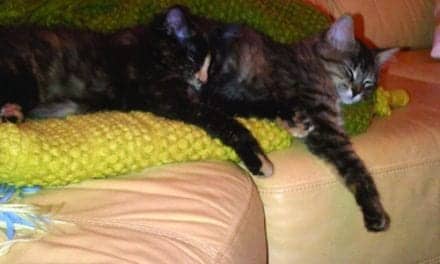Final Word | May 2018 Hearing Review
Merriam-Webster’s online dictionary refers to “hospice” in the context of medical care as: A program designed to provide palliative care and emotional support to the terminally ill in a home or homelike setting so that quality of life is maintained and family members may be active participants in care; ‘also:’ a facility that provides such a program. I’ve had personal experience with hospice as close family members approached their end of life, and found the experiences that the hospice care offered were very helpful and comforting.
Recently, I was brought into a hospice situation at the request of a family for whom I have been providing audiology and hearing care for about 25 years. The patriarch, who had a severe loss, experienced a stroke, a fall, and broken hip all in a short period of time. He had been mostly self-sufficient, and lacking his attention, hearing aids and current earmolds were lost. One of his daughters, a physician, sought my help as she was trying to separate any cognitive deficits from the severe hearing loss. At her request, I provided the family with a single hearing aid on loan using an old earmold they had. Within a couple of weeks, the remaining earmold went missing and I was requested to make a home visit to discuss options. I knew the patient was bedridden, but had not been informed that he was on hospice. The family reported that he was responding to shouted speech in one ear, and asked if I could somehow couple the hearing aid to that ear. He was refusing food and likely would not last more than a couple of weeks.
My preparation for the home visit did not include stock or temporary earmolds, or any type of assistive device. I was there prepared to take an impression, and not much more. I did have some tools for cerumen management and simple hearing aid maintenance. We discussed options, including taking an impression that would incur a waiting period and the cost of another home visit. Of course, he had more cerumen than would allow a proper ear impression.
Taking stock of my capabilities and assets, I came up with a short-term treatment plan. I offered to make a temporary earmold from silicone impression material, tube it, and fit it to the ear that showed a response. The family agreed. Following cerumen removal, which is in our scope of practice in California, I took an impression with a shallow concha and no helix with a longish canal up to the second bend. Once it cured, I trimmed the edges and canal and assessed the physical fit and ease of insertion and removal.
So far, so good.
Now I had to figure out how to fashion a bore through the mold that would accept the tubing. I chose the closest thing I had to a core drill: a Buck curette. Twisting the curette as it advanced through the silicone, I was able to cut a ragged hole down the center of the canal. I reversed the curette, passed it from the canal end back through the passage I had just made, and threaded the quilled end of stiff Dri-Tube #13 tubing into the opening in the curette, and pulled it through to a proper angle on the mold. As I had hoped, the stiff Dri-Tube didn’t collapse from the pressure of the imprecise bore I had fashioned, and I had a functional, but not very pretty, behind-the-ear (BTE) earmold.
The patient lived about another two weeks, and was able to use the hearing aid and mold for short periods of time, but he wasn’t in the mood for any stimulation: touch, light, or auditory. Following his passing, the family called and thanked me for making the effort to allow them to communicate with him.
What is our responsibility in such situations? I had to dramatically change my expectations when my mother was assigned to hospice. The care went from life-extending traditional treatment to palliative care to ensure comfort, but did not include IV hydration and nutrition to extend life. That was a new and difficult concept to accept. In the case of this bedridden patriarch patient, there were fleeting moments of clarity that the hearing aid was required to exploit, allowing the family to say their goodbyes and offer comfort to him. Hospice in this situation involving a hearing aid followed the rule of comfort, but wasn’t necessarily the most cost-effective approach.
The Final Word? This was one of those situations we sometimes face where there are many obstacles to overcome, and we wonder if it makes sense to keep dodging them.
In this case, I followed the spirit of hospice by doing what could be done in a short period of time, and respected the family’s wishes to do only what was necessary to achieve the goals of comfort and communication. I feel okay about that, but I’ll miss him.
Citation for this article: Van Vliet D. Audiology in palliative care. Hearing Review. 2018;25(5):50.







I would have done the same. When our patients can’t come to us, sometimes a temporary earmold or the loan of a demo aid or Pocket Talker (for less severe hearing loss) is the right thing to do. I suspect you’ll add a core drill to your mobile kit in the future after this experience, just in case!